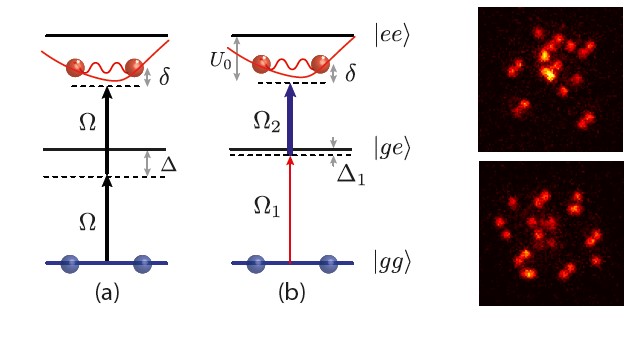Realizing Rydberg induced long-range interactions in itinerant lattice systems
Summary
The goal of this project is to use Rydberg macrodimers – molecules consisting of two bound Rydberg atoms – to enhance existing schemes for Rydberg dressing and to finally leaving the frozen gas regime and entering the itinerant regime.Rydberg dressing - the admixture of strong Rydberg interactions into the ground state by off-resonantly coupling to a Rydberg state – reduces the admixed interaction energies as well as the decay rates associated with the Rydberg state closer to the much smaller timescales associated with atomic motion. In practice, Rydberg dressing is currently limited by the off-resonant scattering at the Rydberg state. This is especially problematic due to the collective nature of the scattering events, which can occur if the scattering leads to a population of other Rydberg states in the energetic vicinity of the one optically coupled to. In this case, the strong interactions of the optically coupled Rydberg state and the Rydberg impurity populated by the off-resonant decay can lead to further resonant excitations at specific distances where the strong interaction compensates for the laser detuning.
Since macrodimer resonances occur very far detuned from the bare Rydberg resonance where collective losses are almost absent, we propose to dress to these molecular resonances instead of to the bare Rydberg state to increase the ratio of interaction and decay. To further enhance the optical coupling to the molecule, we propose a two-color excitation by modulating a weak sideband on our ultraviolet laser. In this scheme, the intermediate state detuning of the two-photon excitation to the macrodimer state can be tuned by the sideband frequency and collective losses are weak because only a small amount of the available UV power is in the near-resonant sideband.
As an alternative approach to enter the itinerant regime, we propose to use the macrodimer excitation as a fast dissipative process to suppress tunneling of atom pairs at the molecular distance due to the quantum Zeno effect. If the scattering rate of a macrodimer state exceeds the tunneling rate, the absence of scattering continuously projects out the fraction of the wave function where two atoms are located at the distance of the molecule.
The local resolution of our quantum gas microscope as well as the strong optical coupling provided by a new UV laser system which will consist of two resonant frequency doubling stages will allow us to probe the admixed interactions at a microscopic level.

Principal Investigator
Immanuel Bloch, Max-Planck-Institut fuer QuantenoptikBack to all GiRyd projects
